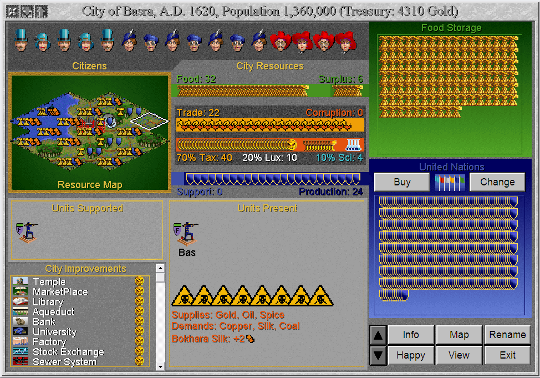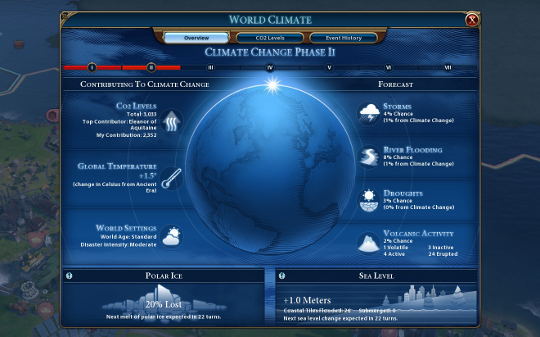Traditionally, the relationship between humans and our environment has not been the most prominent aspect of historical writing. Particularly before the institutionalization of historical studies in the nineteenth century, the natural world generally took a backseat to kings, monuments, explorers, and revolutions. It usually only made the history books when there was a flood, a plague, or some other cataclysmic event reminded us that there were other forces beyond the deeds of Great Men that had the power to shape history.
Of course, every medium has its affordances and constraints, so naturally, you get a very different experience of history from playing a game than reading a book. As Ian Bogost points out in his discussion of procedural literacy (2005), strategy games like Civilization “represent history through rules of interaction rather than patterns in writing.” While playing Civ won’t give anyone much help on a history test, it excels at helping players understand the importance that geography, resource distribution, and other material conditions have in shaping the course of human history. This is also why I am interested in what such games have to say about how human actions shape the natural world around us and how those messages have changed over the years.

Human impact on the environment is often on my mind, as my hometown has once again managed to secure a place on the list of the top ten cities with the worst air pollution in the United States. Of course, it would be difficult to avoid the various discourses surrounding pollution, climate change, and environmentalism, as they suffuse through everything from elementary school textbooks to Hollywood films to cable news. One of the biggest challenges for science communicators and activists across all media is the fact that issues like climate change are incredibly complex and difficult to directly observe. I can’t see the ice caps slowly melting when I leave my car idling and I can’t feel the air get warmer every time I take a bite of factory farmed beef. Systems like the climate are non-linear, governed by multiple stocks and flows which provide diverse and often delayed feedback. For this reason, climate scientists like John Sterman (2011) have suggested that politicians and policy makers, as well as the public, should try using interactive simulators and learning environments in order to better understand the mechanisms that drive the earth’s climate.
Though commercial strategy games are a far cry from Sterman’s detailed politician-educating simulators, ecology features as a prominent theme in many series. Master of Orion in particular foregrounds ecology as a mechanic, making it one of the six main areas of production, right alongside building units and researching technology. There are dozens of ecological technologies that can be researched, focusing on issues like waste disposal, environmental restoration, and soil enrichment. There is even an “environmentalist” script that can be assigned to AI opponents.

Ecology is clearly a big deal in Master of Orion, but how does it actually work? As a planet’s populace and factories generate production, they also create waste, which must be cleaned up. By default, your planets will always try to dedicate whatever amount of their production is necessary to clean up all the waste they produce, every turn (unless you’re playing as Silicoids, who don’t seem to mind living in a toxic hellscape). Players can choose not to dispose of all their waste if they are desperate to build ships or some other project, but this is generally a poor long-term strategy. As waste builds up, the total number of colonists that the planet can support goes down. If this number falls below the number of actual colonists on a planet, the population will begin to be killed off by pollution. Since polluting the environment was generally a terrible idea that the player essentially had to opt-in to, most players never really had to think about the pollution mechanic unless there was an industrial accident or they happened to take over a Silicoid colony.

When Master of Orion 2 was released, it streamlined many of the mechanics of its predecessor, including pollution. Cleaning up pollution became not just the default, but an automatic process. Pollution became little more than a numerical factor that curbed overall production, much as maintenance costs were subtracted from your income and food for your population was subtracted from your overall harvest. Indeed, even if you captured a planet from the Silicoids (who still didn’t clean up their messes), there was no way to represent environmental damage, so you still ended up with a squeaky clean new planet.
The Master of Orion series’ representation of environmentalism, as one might expect from a science fiction game, is Utopian. Protecting the environment, even when you’re fighting an interstellar war, is just common sense. Any sensible civilization must use all the resources at its disposal to clean up pollution and safeguard the environment because the alternative is catastrophic, though these consequences (which are an important aspect of the climate change debate to understand) become obfuscated from the player in the sequel.
While this vision of environmentalism is certainly aspirational, it provides little insight into the actual challenges we face in confronting environmental issues. As with most challenges the player faces in the game, every environmental issue has a simple technological solution. Even the worst environmental damage can eventually be repaired. Even the creation of pollution will eventually be completely eliminated. Furthermore, since a planet is the most basic spatial unit on the game map, every planet is completely controlled by a single faction. There are no competing interests, no politics. The choices that one player makes don’t impact any others and vice versa.
One of the most interesting pollution mechanics that I’ve seen can be found in Civilization II. Although not nearly as prominent as in Master of Orion, Civ II’s pollution mechanic is relatively complex when compared with other games of its time. As in Master of Orion, pollution a generic representation or a number of kinds of environmental damage, including air pollution, industrial waste, and nuclear fallout. While it generally isn’t a concern for your civilization in the stone age, it usually starts to appear long before the Industrial Revolution. Large medieval cities will often find an ominous skull marker beside them on the map, showing a location that has been fouled by the waste from the city. There is still incentive for the player to try and clean these areas up, as polluted ground is less productive, but these concerns usually remain a local problem.
It’s not until the development of of technologies like industrialization and the automobile that pollution becomes a major issue. As with most games in this genre, there is still always a technological solution to any problem, however, while later technologies allow the player to build mass transit systems, solar plants, and recycling centers to reduce or even eliminate pollution in her cities, neither stabilizing nor eliminating a city’s emissions will completely solve all environmental problems. Though certainly not as complex as the actual world or even Sterman’s proposed simulators, the environment of Civilization II is made up of stocks and flows. Cutting of the flow of pollution into the environment is important, but does not in itself reduce the stock of pollutants already in the system. Even if every city on the map becomes completely clean, if enough damage has already been done, the planet can still experience global warming.

Global warming in Civ II is a fairly catastrophic event. When it occurs, nearly every tile on the map can be impacted. Coastal tiles flood, becoming swamps. Inland plains become barren deserts. Both player-constructed improvements like farms and natural resources like silk can be destroyed. For the player, this means that the amount of food and raw materials available to her cities is drastically reduced. This means that cities across the world will begin to starve, research and production will slow, and existing military units that can no longer be supported will be forced to disband. Even worse, unless the pollution in the environment is cleaned up (which is even more difficult to do when you have to trudge through a swamp to get to it), the cycle will continue to repeat, spreading the devastation even further.

Major global warming events are random occurrences, but the likelihood of them increases with every polluted square on the map. Global warming can occur with as few as nine tiles in the entire world polluted. With such an existential threat as the potential cost, even unlikely odds are not worth the risk. As such, if one nation is polluting the environment and is unwilling or unable to clean it up, the most sensible course of action is often to declare war on them, conquer their cities, and then clean up the mess yourself. This is probably the most extreme example of environmental politics I’m familiar with in a videogame, but within the context of the game world, it makes perfect sense. No military or diplomatic cost outweighs the cost of failure. This cost was famously documented in one game of Civ II that lasted for ten years, with all sides locked in an endless nuclear war and the world reduced to an endless wasteland of irradiated swamps. With no resources left with which to restore the environment and no trust between the surviving factions, the only option was to accept a near constant cycle of natural disasters while trying desperately to make the slightest change to the front lines.
Again, as with Master of Orion, later entries in the Civilization franchise attempted to streamline some of the Byzantine complexity of Civ II, and the environmental systems were among those most affected. The cataclysmic effects of climate change were removed and the various human factors that negatively impact the environment slowly disappeared. By the time of Civilization V, the only form of pollution that remained was the fallout created by nuclear weapons. Since there was no global climate mechanic, however, fallout was merely a local problem that one player alone had to worry about.
While I generally approve of the strides that developers have taken to make strategy games more interesting and more accessible to new players, I have long lamented the fact that the game systems that created such thought-provoking perspectives on the relationship between humans and the environment have slowly been phased out for the sake of simplicity. Imagine my surprise when Gathering Storm, the latest expansion to Civilization VI was announced, with climate change and natural disasters as its central theme. My biggest question, of course, was how would it compare to the heavy-handed environmental systems of Civ II.
Though natural disasters in Gathering Storm occur from the beginning of the game, the human capacity to influence the environment are specifically linked to the CO2 emissions from power plants and units that consume fossil fuels. Coal plants are the worst polluters, followed by oil and nuclear power. Eventually, the ability to construct hydroelectric dams, solar farms, geothermal plants, and wind farms can supplement and even replace these power plants, allowing them to be decommissioned.

Unlike Civ II’s generic skulls that represented any kind of environmental damage, Gathering Storm goes to great lengths to create a detailed representation of how CO2 levels in the atmosphere change the global temperature, polar ice, and sea level. It also indicates how much more severe storms and floods have become due to human activity. While there are still technological solutions like flood barriers and carbon recapture (no need to invade your neighbors to clean up their mess), there is no way to completely undo the effects of climate change once they’ve been allowed to occur.

A player can probably gain a more complex understanding of climate change by playing Gathering Storm than any other strategy game I’m familiar with, though there are still some aspects that I think earlier games deal with better. Despite being the central theme of the expansion, climate change has yet to have a major impact on any of the games I’ve played. Even when I decided to completely ignore my carbon footprint, easily dumping ten times the carbon of my closest competitor into the atmosphere, the consequences of my actions had only just begun to appear by the end of the game. The developers increased the damage from climate change induced disasters in the most recent patch, though in my experience, they still come so late in the game that I still have yet to really see them in action. The game also ignores carbon emissions from sources like cars, which in my neck of the woods is a fairly major contributor to our smog problem. We also don’t see environmental issues beyond carbon emissions, such as Master of Orion’s pollution from industrial accidents (it’s interesting that pillaging offshore oil rigs doesn’t create a Deepwater Horizon-style disaster) or the contaminated landscapes of Civ II (though the fallout mechanic remains, emphasizing the risks of nuclear power).

While there are certainly plenty of areas of environmentalism left for the Civ franchise and other games to explore, Gathering Storm’s message is well-formulated and precise. It emphasizes a number of stocks and flows like carbon emissions, polar ice, and atmospheric CO2 levels. It draws a careful connection between climate change and extreme weather events, emphasizing that while such events have always occurred, human-produced carbon emissions have a significant, measurable effect on them. Perhaps most interestingly, although Gathering Storm is still built upon a great deal of technologically deterministic assumptions, it portrays the most serious consequences of climate change as permanent, irreparable damage to the earth. After several decades of decreasingly complex representations of ecology in strategy games, Gathering Storm is a refreshing change of pace. I hope it’s the start of some interesting new trends.
References
Ian Bogost. (2005). Procedural Literacy. Telemedium.
John Sterman. (2011). Communicating Climate Change Risks in a Skeptical World. Climatic Change.
